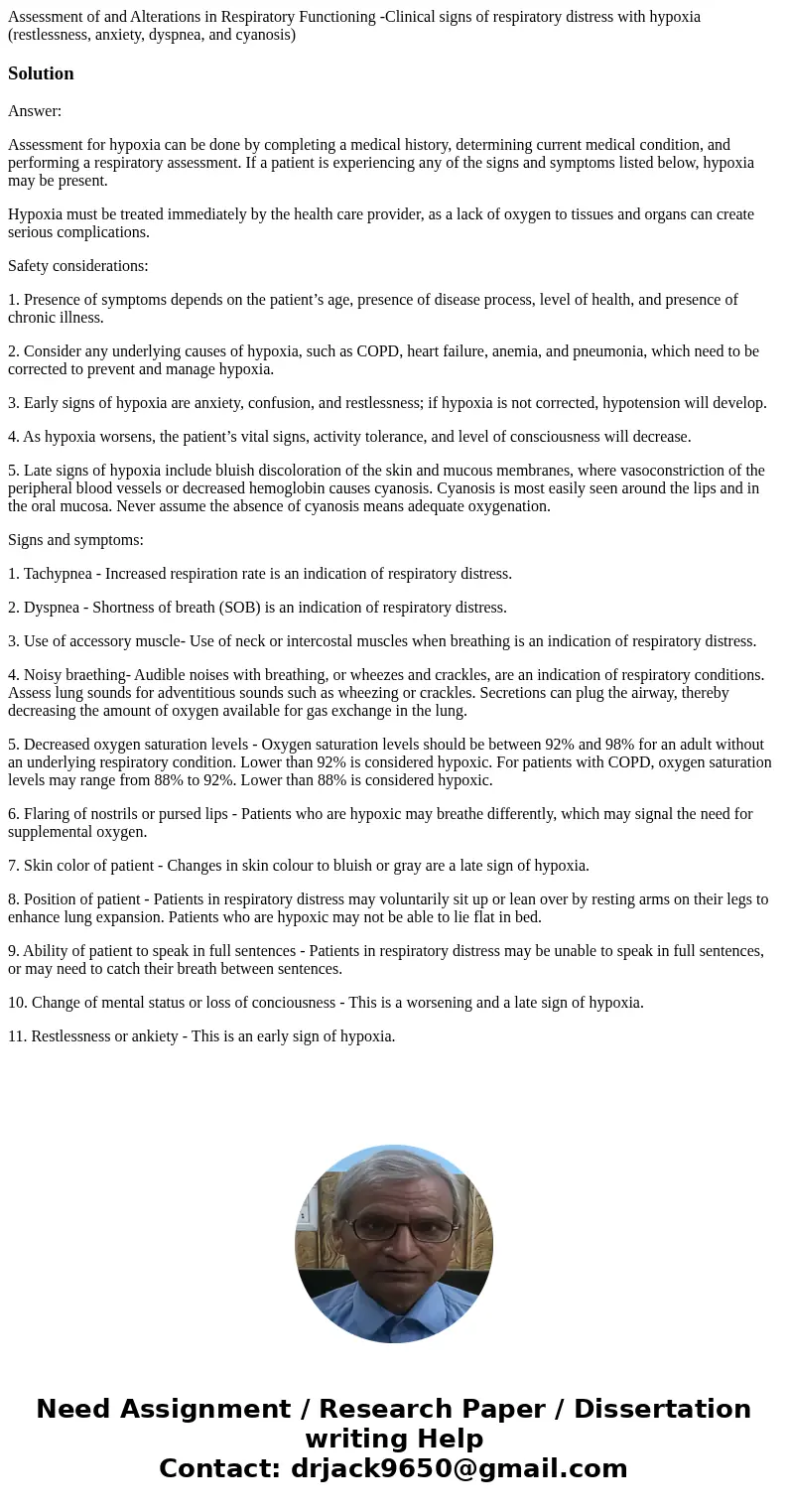Assessment of and Alterations in Respiratory Functioning Cli
Assessment of and Alterations in Respiratory Functioning -Clinical signs of respiratory distress with hypoxia (restlessness, anxiety, dyspnea, and cyanosis)
Solution
Answer:
Assessment for hypoxia can be done by completing a medical history, determining current medical condition, and performing a respiratory assessment. If a patient is experiencing any of the signs and symptoms listed below, hypoxia may be present.
Hypoxia must be treated immediately by the health care provider, as a lack of oxygen to tissues and organs can create serious complications.
Safety considerations:
1. Presence of symptoms depends on the patient’s age, presence of disease process, level of health, and presence of chronic illness.
2. Consider any underlying causes of hypoxia, such as COPD, heart failure, anemia, and pneumonia, which need to be corrected to prevent and manage hypoxia.
3. Early signs of hypoxia are anxiety, confusion, and restlessness; if hypoxia is not corrected, hypotension will develop.
4. As hypoxia worsens, the patient’s vital signs, activity tolerance, and level of consciousness will decrease.
5. Late signs of hypoxia include bluish discoloration of the skin and mucous membranes, where vasoconstriction of the peripheral blood vessels or decreased hemoglobin causes cyanosis. Cyanosis is most easily seen around the lips and in the oral mucosa. Never assume the absence of cyanosis means adequate oxygenation.
Signs and symptoms:
1. Tachypnea - Increased respiration rate is an indication of respiratory distress.
2. Dyspnea - Shortness of breath (SOB) is an indication of respiratory distress.
3. Use of accessory muscle- Use of neck or intercostal muscles when breathing is an indication of respiratory distress.
4. Noisy braething- Audible noises with breathing, or wheezes and crackles, are an indication of respiratory conditions. Assess lung sounds for adventitious sounds such as wheezing or crackles. Secretions can plug the airway, thereby decreasing the amount of oxygen available for gas exchange in the lung.
5. Decreased oxygen saturation levels - Oxygen saturation levels should be between 92% and 98% for an adult without an underlying respiratory condition. Lower than 92% is considered hypoxic. For patients with COPD, oxygen saturation levels may range from 88% to 92%. Lower than 88% is considered hypoxic.
6. Flaring of nostrils or pursed lips - Patients who are hypoxic may breathe differently, which may signal the need for supplemental oxygen.
7. Skin color of patient - Changes in skin colour to bluish or gray are a late sign of hypoxia.
8. Position of patient - Patients in respiratory distress may voluntarily sit up or lean over by resting arms on their legs to enhance lung expansion. Patients who are hypoxic may not be able to lie flat in bed.
9. Ability of patient to speak in full sentences - Patients in respiratory distress may be unable to speak in full sentences, or may need to catch their breath between sentences.
10. Change of mental status or loss of conciousness - This is a worsening and a late sign of hypoxia.
11. Restlessness or ankiety - This is an early sign of hypoxia.

 Homework Sourse
Homework Sourse